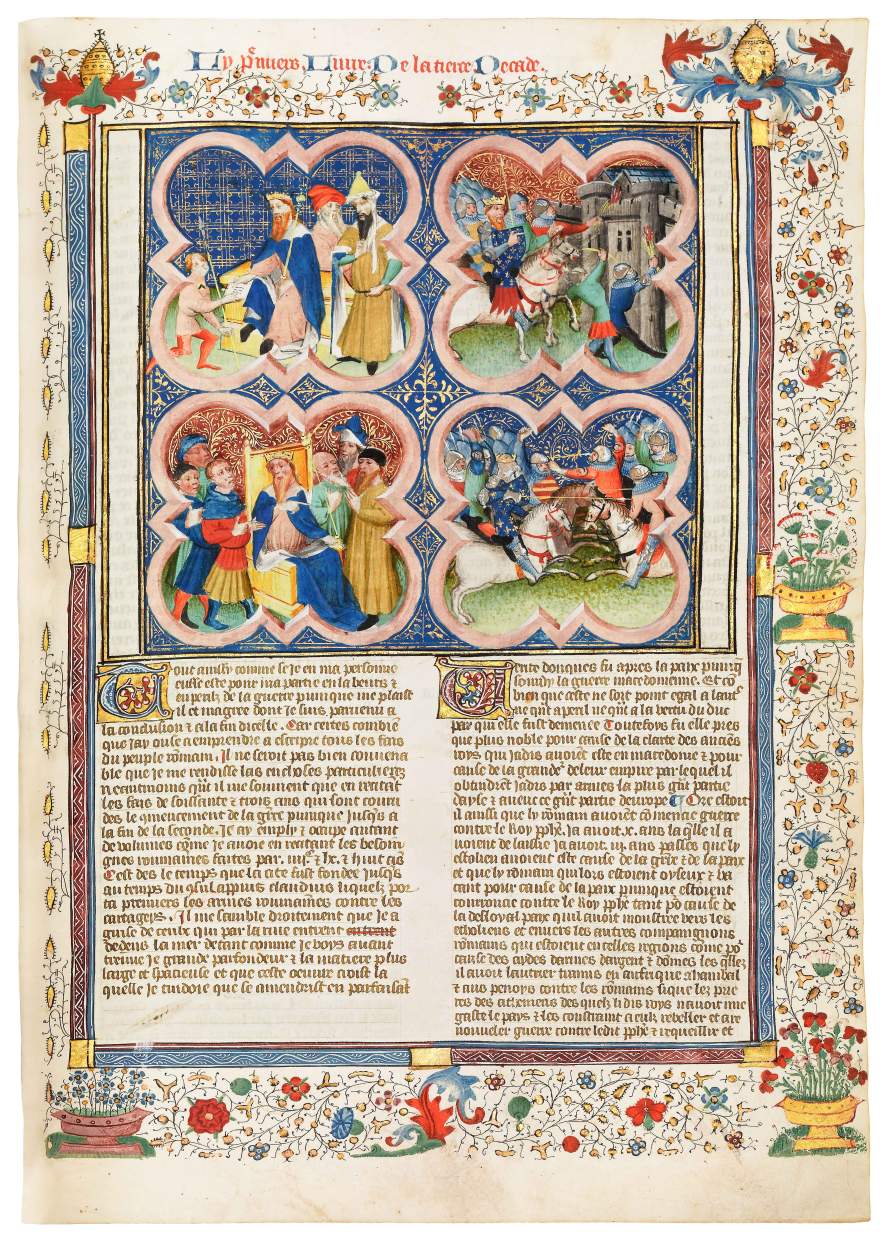Artworks


Titus Livius, Les décades, in French
Manuscript written by Jeannin de Rouen, illuminated by Henri d’Orquevaulz
France, Metz, 1440
450 x 318 mm, 375 leaves, 87 miniatures
Third decade, fol. 1, composition with four miniatures: the Roman declaration of war being delivered to Philip V of Macedon, the armies of the consul Sulpicius setting fire to Macedon,Sulpicius receiving an audience from neighbouring kings, and the battle between the Romans and the Macedonians
Hide caption


Titus Livius, Les Décades, in French
Manuscript written by Jeannin de Rouen, illuminated by Henri d’Orquevaulz
France, Metz, 1440
450 x 318 mm, 375 leaves, 87 miniatures
Sea battle


Titus Livius, Les Décades, in French
Manuscript written by Jeannin de Rouen, illuminated by Henri d’Orquevaulz
France, Metz, 1440
450 x 318 mm, 375 leaves, 87 miniatures
last page: Jean de Vy, with his coat-of-arms, kneeling in prayer before the Virgin and Child – The scribe Jeannin de Rouen writing the present manuscript, and Henri d’Orquevaulx illuminating it


Titus Livius, Les Décades, in French
Manuscript written by Jeannin de Rouen, illuminated by Henri d’Orquevaulz
France, Metz, 1440
450 x 318 mm, 375 leaves, 87 miniatures
Binding à la Fanfare, c. 1580


Titus Livius, Les Décades, in French
Manuscript written by Jeannin de Rouen, illuminated by Henri d’Orquevaulz
France, Metz, 1440
450 x 318 mm, 375 leaves, 87 miniatures
Second decade, fol. 14, the battle between Hannibal and the Gauls
Hide caption

Titus Livius, Les Décades, in French
Manuscript written by Jeannin de Rouen, illuminated by Henri d’Orquevaulz
France, Metz, 1440
450 x 318 mm, 375 leaves, 87 miniatures
Hide caption
This work is now sold.
See our video presentation of this manuscript here.
The great Roman historian Titus Livius (d. 17 AD) wrote his Ab Urbe Condita in 142 books, divided into ‘decades’ of ten books each. During the Middle Ages only decades I and III-IV were known. Jean le Bon, king of France (1350-1364) commissioned a French translation of all of Livy that was known at that time from Pierre Bersuire, friend of Petrarch. It was the first translation of any major classical author into French (1358).
With 87 splendid miniatures this is one of the most richly illustrated of all known copies of Livy. The standard cycle of illustrations for manuscripts of Les décades had 30 pictures altogether (one for each book), arranged as frontispieces of four images at each of the three decades, with 26 smaller miniatures throughout the text. This was the norm, even for the grandest royal copies. Some have fewer pictures, or none at all. In the present manuscript, however, many chapters have illustrations within each book. Even though some of the quires have been damaged by moisture, this is a most impressive, large format book with most delightful illustrations painted in a stunning palette of well-preserved colours. This codex offers everything that the Middle Ages are supposed to be: battles, jousts, knights, armour, castles, trumpeters, kings, maidens, banquets and so on – in a profusion of colour and chivalric splendour.
The makers of this manuscript are not only named but there is also an extraordinary self-portrait of the artist, Maître Henri d'Orquevaulx, with a portrait of the scribe, along with that of their patron, Jean III de Vy (d. 1449), écuyer and échevin of Metz. He bequeathed the Livy to his great nephew, Pierre Baudoche, son of Jean Baudoche, as is revealed (with further family information) in the long inscription on the last page, and the name in large gothic script inside the lower cover,
Also on that last page, a remarkably detailed account of the transmission of the text is added. It tells that King Jean originally had the book translated. He gave it (or a copy, at least) to his daughter, Marie, Duchesse de Bar (1344-1404), and she presented it to her son, Edouard, Duc de Bar, who was killed at Agincourt in 1415, and so it was passed to his brother instead, Cardinal Louis de Bar, who died in 1431, naming his heir as King René of Anjou (1409-80). When René went to Italy in 1438 to claim the kingdom of Sicily, he entrusted the manuscript to Robert de Baudricourt (c. 1400-1454), protector of Joan of Arc, bailli of Chaumont (in the duchy of Bar), who lent it to Jean de Vy, eschevin, son of Jean de Vy, chevalier, who had it copied. This detailed provenance of the royal copy is known only from the present inscription. If the manuscript was indeed transcribed directly from an exemplar from the royal library, it is likely to be of exceptional purity. The text was checked gathering by gathering, for the words “correct[us] est” are added at the end of quires 1-3 and 24 (the latter in red ink).
Read more about this manuscript in our Spotlight.



